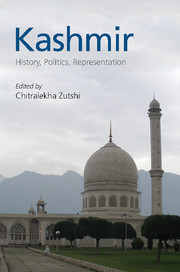Book contents
- Frontmatter
- Dedication
- Contents
- Acknowledgements
- Map 1 Pre-Partition Jammu and Kashmir
- Map 2 Contemporary Kashmir
- Introduction: New Directions in the Study of Kashmir
- PART I HISTORY
- PART II POLITICS
- PART III REPRESENTATION
- 11 Embedded Mystics: Writing Lal Ded and Nund Rishi into the Kashmiri Landscape
- 12 Producing Paradise: Kashmir's Shawl Economy, the Quest for Authenticity and the Politics of Representation in Europe, c. 1770–1870
- 13 The Kashmiri as Muslim in Bollywood's ‘New Kashmir films’
- 14 The Witness of Poetry: Political Feeling in Kashmiri Poems
- Contributors
- Index
14 - The Witness of Poetry: Political Feeling in Kashmiri Poems
from PART III - REPRESENTATION
Published online by Cambridge University Press: 03 August 2019
- Frontmatter
- Dedication
- Contents
- Acknowledgements
- Map 1 Pre-Partition Jammu and Kashmir
- Map 2 Contemporary Kashmir
- Introduction: New Directions in the Study of Kashmir
- PART I HISTORY
- PART II POLITICS
- PART III REPRESENTATION
- 11 Embedded Mystics: Writing Lal Ded and Nund Rishi into the Kashmiri Landscape
- 12 Producing Paradise: Kashmir's Shawl Economy, the Quest for Authenticity and the Politics of Representation in Europe, c. 1770–1870
- 13 The Kashmiri as Muslim in Bollywood's ‘New Kashmir films’
- 14 The Witness of Poetry: Political Feeling in Kashmiri Poems
- Contributors
- Index
Summary
Concertina wire is the most widespread form of vegetationin Kashmir today. It grows everywhere, including in the mind.
Much of the extraordinary violence that Kashmir has seen over the last two decades and more has been documented by Kashmiri and international human rights groups, civil society activists and journalists. However, the effect such long-term violence has had in the forging of political subjectivities has not become central to scholarship on contemporary Kashmir. That Kashmir has become a conflict zone, with periods of intense violence followed by months of relative calm, is acknowledged by all, but commentators rarely factor in the effects of such prolonged instability and suffering on the political and social attitudes of Kashmiris today. Analysts tend to focus on political developments and incidents of violence in the moment, and even those who recognize that there is an entire generation and more whose only sense of ‘normality’ is of a conflict-ridden Kashmir, make this observation only to set it aside. Noticeably absent from such analyses is a sense of traumatized lives under siege, or of the way in which the pressure of events transforms subjectivities and repurposes political priorities over time.
But loss and traumatic experiences are now woven into the fabric of Kashmiri lives: everyone has first-hand accounts of violence to offer and people often call attention to their experiences as they explain their political positions. I have suggested elsewhere that creative texts produced in times of conflict offer a way of addressing crucial lacunae in our understanding of Kashmir and Kashmiris, for they illuminate not only the political and ideological issues at stake, but also states of being precipitated by violence, loss and resistance. For instance, poems from conflict zones are sure guides to the intensity of feelings that result from prolonged conflicts, and which, over time, play a significant role in the perpetuation of the conflict. This can be a matter of idiom and tone, for the performative elements of a poem emphasize emotional and psychological intensities sidelined in the affectively-neutral tones of news reportage, policy documents, or standard historiography (Kaul, 2015). As Muzamil Jaleel noted early in the period of conflict, Kashmiri poetry had become a crucial medium for the articulation of trauma and of protest in a time when censorship and fear made writing in prose dangerous (2002).
- Type
- Chapter
- Information
- KashmirHistory, Politics, Representation, pp. 301 - 324Publisher: Cambridge University PressPrint publication year: 2017
- 1
- Cited by

